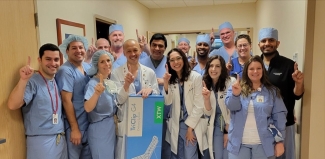According to new research published online ahead of print in the September 2021 issue of American Heart Journal, residents in the rural community of New Ulm, MN experienced fewer cardiovascular (CVD) events during nine years of The Heart of New Ulm Project (HONU) interventions when compared with a matched rural Minnesota community. From 2009 to 2018, the Minneapolis Heart Institute Foundation® (MHIF) and Allina Health conducted HONU in New Ulm as a 10-year population-based prevention demonstration project, designed to identify and deliver the best interventions to reduce cardiovascular disease at a population level.
Prevention researchers from MHIF’s Nolan Family Center for Cardiovascular Health and Allina Health compared a sample of 4,056 New Ulm residents matched with 4,056 residents from a different community also served by Allina Health. They found that while the proportion of residents in New Ulm with a major CVD event (myocardial infarction, ischemic stroke, percutaneous coronary intervention (PCI), coronary artery bypass graft (CABG), and CVD-related death) was not significantly different than the comparison community, the total number of events did differ by community. New Ulm experienced 83 fewer CVD events than the comparison community; the difference appeared to be mainly driven by the significantly lower numbers of ischemic stroke events and stenting of the coronary arteries in New Ulm.
According to the researchers, these 83 fewer CVD events in the New Ulm cohort translate into approximately 2 percent fewer events per year, which is a modest but clinically meaningful reduction in the burden of CVD in a small rural population. The lower number of CVD events translate into an estimated $2.1 million in lower CVD care costs (approximately $240,000 annually in 2016 dollar values) in the New Ulm cohort over the nine-year period.
“As we continue analyzing the data from HONU, we see the challenges of implementing effective methods of cardiovascular prevention, but are also encouraged by the successes demonstrated from a population health standpoint,” said Gretchen Benson, director of the Nolan Family Center and lead for population health work through MHIF’s Rural Health Transformation Center. “We’ve seen healthier lifestyle habits among community members, an overall improvement in several clinical risk factors, and now, a modest reduction in CVD events over time. Our work continues to show that a multifactorial approach to community-based CVD prevention can improve health.”
Throughout the 10 years of the HONU research phase, project leaders employed an integrated array of evidence-informed health improvement practices in community settings, health care and worksites. HONU also instituted changes at the policy, systems and environmental levels to promote food and built environments that would support the ability for residents to initiate and sustain lifestyle improvements. The project continues in New Ulm today as a community-owned health initiative.
The reasons for the fewer CVD events/procedures in New Ulm were not directly examined in the latest study, but based on prior analyses, researchers suggest it may be due to greater improvements in CVD risk factors such as blood pressure, lipids, nutrition, and physical activity. In an analysis of CVD risk factor changes within the same matched cohort over the first six years of HONU interventions published in Preventive Medicine, New Ulm residents were doing better in controlling their blood pressure, LDL cholesterol, total cholesterol and triglycerides than those in the other community.
The latest journal article, “The Impact of a Population-based Prevention Program on Cardiovascular Events: Findings from The Heart of New Ulm Project” is available online.



